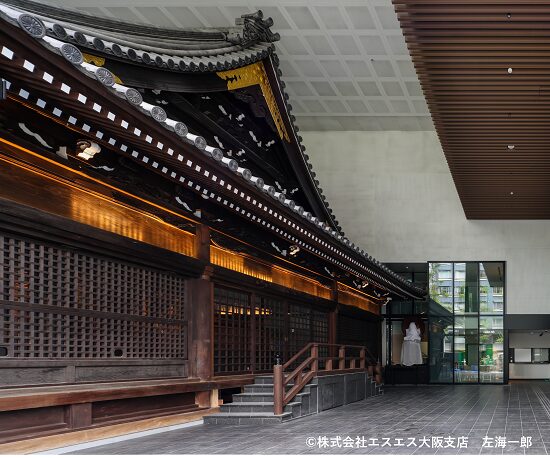In September 2023, a new landmark emerged on Osaka’s Midosuji Avenue: the “Tokyo Tatemono Mitsutera Building.” This unique complex integrates the historic wooden Mitsutera Temple with a hotel and retail spaces, creating an unprecedented blend of a temple with over 1,300 years of history and modern architecture. The project is drawing attention as a new cultural hub for the region.

A Harmonious Space Where Historic and Modern Facilities Coexist
Traditional Architecture Preserved as a Regional Landmark for Future Generations
Mitsutera Temple, a Shingon Buddhist temple founded in 744 by the order of Emperor Shomu, boasts a history spanning 1,300 years. The current main hall, constructed during the Edo period, is a rare wooden structure that survived the Osaka air raids. Inside, statues from the Heian period and lavish Edo-era decorations encapsulate the timeless beauty of Japanese art. However, as with all aging structures, the temple’s preservation and legacy became an urgent priority.
The “Mitsutera Building” project, proposed by Tokyo Tatemono, centered on constructing a building around the main hall, balancing the preservation of the temple with the coexistence of modern facilities. The building’s first floor functions as both temple grounds and hotel entrance, a unique design that encourages interaction between worshippers and guests, transforming the site into a welcoming space for diverse visitors, affectionately known as the “Kannon of Minami.”
A critical aspect of the project was the use of “hikiya,” an ancient method for moving buildings. Prior to construction, the main hall of Mitsutera Temple was carefully detached from its foundation and relocated multiple times to face Midosuji Avenue. This relocation employed the utmost precision in safety management, vibration control, and cultural property protection, harnessing sophisticated technology previously unseen in such projects.
The chief priest of Mitsutera expressed joy in a media interview last year, stating, “By employing hikiya, we preserved the main hall, allowing it to face Midosuji Avenue as a symbol of the community.” Inside the building, statues from the Heian and Edo periods are enshrined, and new facilities have been introduced to support the local faith and cultural heritage.
The Tokyo Tatemono Mitsutera Building is not merely a structure; it serves as a bridge for passing Mitsutera Temple’s spirit to future generations. The integration of traditional and modern architecture is exemplified by other similar projects, such as Tokyo’s Kabuki-za, where a historic theater coexists with a skyscraper. Enveloping Japan’s traditional architecture within contemporary structures or blending heritage buildings with modern areas presents promising possibilities. Ideally, such approaches align with the growing trend of wooden skyscrapers in Japan, shaping the next era of environmentally conscious architecture.
